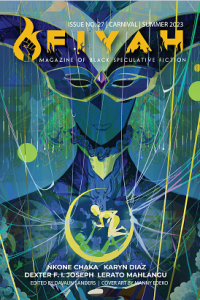Russell Letson reviews Ann Leckie
Sometimes I wonder whether there are hidden clockworks in the SF metagenre, governing the recirculation and regeneration of various tropes, traditions, memes, and subtypes. Or maybe it’s just a chaotic system that every so often kicks up a clump of mutually resonating stories. Whatever the mechanism, I have noticed a relatively recent burst of novels that remix the components of the future-soldier story in compelling and sometimes unexpected ways, from the likes of James S.A. Corey, Linda Nagata, and Ann Leckie. Or maybe such books are always around and I’m just selecting the ones that catch my attention and get added to my perhaps-idiosyncratic list of personal-favorite producers of ‘‘military’’ (scare quotes deliberate) SF: Walter Jon Williams, Karen Traviss, Scott Westerfeld, and Eleanor Arnason, right back to Joe Haldeman and Old Man Heinlein himself.
Ann Leckie’s debut novel, Ancillary Justice, created instant buzz in the field and then took a thoroughly deserved fistful of big awards, so I picked up its sequel with a mixture of hope and anxiety: please let this second act not disappoint. To my delight, Ancillary Sword is an even stronger book, though it takes an interestingly different path than the one that made Justice a bit of a magical mystery tour de force. The first novel seemed determined to press ahead on all fronts of alienness and alienation: gender identity, distributed (or artificial) personhood, exotic cultures, ancient-future-history, and a deep and complicated backstory. Ancillary Sword slows things down considerably, as though, having established six impossibly defamiliarizing things before breakfast, Leckie could kick back and unfold some of the implications of her densely-imagined world.
For the handful of readers who have not yet read Ancillary Justice, a brief orientation. (The rest of you just text among yourselves or check your e-mail.) The setting is a now-ancient human interstellar polity dominated by the relentlessly, violently expansionist civilization of the Radchaai. The protagonist and narrator is the only surviving unit of what was once an entire company of ancillaries, brain-burned soldiers animated by the AI mind that also operated a military starship. Reduced to a single body and nervous system, with memories of what it felt like to be a warship and a small army, the individual calling herself Breq sets off to confront the party responsible for her near-destruction: Anaander Mianaai, the many-bodied, single-personality’d absolute ruler of the Radch.
The most striking differences between the books are setting and scale. Instead of sending Breq off across multiple planetscapes and alternating present-action scenes with decades (and eventually centuries) of back-story, Ancillary Sword limits itself mostly to a single orbital station and one patch of the planet it governs. The focus is on smaller-scale social and interpersonal dynamics that, along the way, also allow consideration of what it means to be a Roman-style empire and an eater of cultures. As in Justice, several genres converge in the story: space opera, palace intrigue, and a bit of murder-mystery (including a library scene and confrontation with the perpetrator), but the dominant atmosphere is of the military-flavored social novel, with relationships cautiously established, authority and responsibility tactfully enforced, and social routines and rules meticulously followed or deliberately violated. The ‘‘intrigue of manners’’ mode that terminated the previous book dominates the whole of this one. This is the milieu of Walter Jon Williams’ Dread Empire sequence, C.J. Cherryh’s Foreigner series, Eleanor Arnason’s Ring of Swords, and parts of Patrick O’Brian’s Napoleonic-navy novels, and, as in them, the civilized interplay of custom and tradition and decorum dances over the constant possibility of violence and destruction.
Following the open break between contending factions of Anaander Mianaai’s distributed self, Breq has been made a fleet captain – roughly a commodore – and been dispatched to ensure the safety of the Athoek system and its attendant orbital station, where understanding of the seriousness of the intrapersonal civil war has not yet reached. And as serious as security issues are, Breq finds more than the Athoeki to worry about. Lieutenant Seivarden, the time-stranded officer she rescued and rehabilitated in Justice, has become an able second-in-command, but now there is another damaged subordinate to look after: the 17-year-old ‘‘baby lieutenant’’ Tisarwat, who is not what she appears to be and who needs reconstruction as badly as Seivarden did. Nor is she the only stray, orphan, bully, or victim, that Breq will encounter. There is a reeducated former plantation worker whose conditioning prevents her from expressing her anger directly; the spoiled, sadistic daughter of a very influential tea-grower; the bereaved sister of an officer from Breq’s previous life; and a bitterly furious indentured worker and her vulnerable younger sibling. Then there are problems and puzzles with local governance and culture; tensions within the station’s multicultural population; questions of the loyalties of military and civil authorities; possible corruption and abuses in the local economy and tea-plantation system; and eventually an attempt on Breq’s life.
Breq’s implant-enabled mental connections to her Ship, the Station AI, and some of her implant-equipped human (not ancillary) soldiers give her an edge as an investigator – she is able to eavesdrop on subordinates and observe their unconscious reactions, monitor the progress of Tisarwat, and consult with the Ship and Station AIs. They also allow her first-person viewpoint to roam in ways useful to a narrative – no need to report off-stage events when Breq can see many of them in real time. Perhaps most important, her unique version of personhood (even ancient, many-bodied Anaander was never an AI starship) makes for an unusual kind and degree of understanding and empathy. Breq acknowledges that she is not human, but neither is she incapable of feeling anger, pain, loss, loneliness, and love: her understanding encompasses so much, and her own emotional life echoes so much of what is fully and merely human that she represents a more-than-human superset.
Surrounding Breq’s close-up interactions are the more purely science-fictional attractions of this universe. Radchaai notions of gender identity and gender markers remain a thematic concern, though now proper (Radchaai) language is less foregrounded – all pronouns are feminine, all parents are mothers, and all children are daughters, with little comment or explanation. Now the Radchaai take on gender gets shown from another angle, associated with their cultural arrogance. The Atheoki Genetalia Festival (which involves festooning walls with imitation ‘‘tiny penises’’ in bright colors) is explained by a conventional officer as part of the locals’ not-very-civilized (for Radchaai values of ‘‘civilized’’) practice of ‘‘mak[ing] a division between people with penises and people without’’:
When we first arrived in the system they surrendered right away. Their ruler lost her mind. She thought Radchaai didn’t have penises, and since everyone would have to become Radchaai, she ordered all the people in the system with penises to cut them off. But the Athoeki had no intention of cutting anything off, so they made models instead and piled them up in front of the ruler to keep her happy until she could be arrested and given help. So now, on the anniversary, sir, all the children dedicate their [store-bought pretend] penises to their god.
Then there is the strange, fraught relationship to the extremely potent, alien Presger, which are to humankind ‘‘not enemies so much as predators.’’ We are reminded of their near-magical technology (the unstoppable, undetectable gun that Breq possesses) and get a glimpse of their strangeness in the form of one of their human translators, apparently bred and/or adapted for the job. Her appearance and comportment are distinctly non-Radchaai, and though her perceptions are uncannily quick and sharp, her conversation suggests that her mentality is not human by the standards of any human society:
And they didn’t say anything about this. You’d think they might have, they said lots of other things. Sit up straight, Dlique. Don’t dismember your sister, Dlique, it isn’t nice. Internal organs belong inside your body, Dlique.’’ She scowled a moment, as though that last one particularly rankled.
When Breq asks if she ate many people when growing up, she replies, ‘‘No one I wasn’t supposed to!’’ One hopes to encounter Dlique’s colleagues in later volumes, though her employers might be too scary to contemplate.
The climax, of course, involves interactions that are anything but intimate or polite, and it reveals the corruption that Breq has suspected all along, and a larger possible complication in the empire-wide crisis. It also resolves some of the smaller-scale matters concerning subordinates and social and ethical conflicts in ways that make this book feel self-contained and complete, and not just a mid-series pause. As much as I enjoy space operatics, mind-blowing special effects, and extended unwind-the-conspiracy stories, what I am enjoying most here are the textures of this world and the exploration of social relationships that remain recognizable even in an exotic, imaginary environment. These are the strengths of the novel, which are distinct from those of the tale, the romance, the epic, or the thrill-ride, and it is a great pleasure to see all of them bundled into one package.









